 |
 |
 |
| |
The Inflammatory Debate: Is it the Virus, the Drugs, or the Host?
|
| |
| |
Summary of Session WEAB01
Reviewed by Charles Hicks, MD; Duke University Medical Center
This interesting session was organized to provide a discussion of an increasingly challenging topic Š what is the relative role of HIV itself, the immune inflammatory response to the virus, and the drugs used for treatment of the infection in a variety of phenomena that impact HIV-infected persons. Topics covered ranged from highly technical lab-based studies to clinical cohort studies of drug toxicity to a discussion by Glaxo SmithKline of data regarding the purported role of abacavir in cardiovascular disease risk. Dr. Judy Currier, one of the topic chairs, closed the session with a superb state-of-the-art discussion of current understanding of cardiovascular disease among HIV-infected persons.
The session was opened by Villarrova and colleagues from Barcelona who presented their work on whole genome transcription analysis of adipose tissue from HIV-infected persons as an investigation of lipodystrophy mechanisms in antiretroviral-treated patients. The study was done using a technique termed whole-genome expression analysis of fat tissue biopsies from 4 groups: HIV-uninfected persons, treatment-na•ve HIV+, and ARV-treated persons with and without lipodystrophy. Compared to HIV-uninfected patients, adipose tissue from HIV-infected patients, even those not yet treated, showed alterations in gene expression of various mediators of inflammation indicating fat tissue is affected early in the course of infection and not only after initiation of antiretroviral therapy. The net effect of these changes is induction of a pro-inflammatory state that may set the stage for subsequent clinically apparent changes in fat tissue among HIV-infected patients. The proposed sequence of events is an initial induction of pro-inflammatory signaling with feedback repression of genes associated with fat accretion and a second wave of pro-inflammatory signaling generating increases in fat catabolism and programmed cell death (apoptosis) of fat cells leading to lipoatrophy. Clearly, much more work is needed to determine the relative impact of the virus, the treatment regimen and the immune response in the mix of changes that result in clinical lipodystrophy.
In a second basic science-based study presented during this session, Boger and co-investigators (see slides below) from Vanderbilt reported results of a pilot study measuring urinary markers of endothelial function and oxidant stress as predictors of cardiovascular disease risk among HIV-infected patients on antiretroviral therapy. Since this sort of specimen is obviously simple to obtain, data suggesting value to this approach would be appealing. Hypothesizing that ARV-associated metabolic effects are mediated by damage to blood vessels (endothelial damage), the investigators sought to determine whether it might be possible to use the quantitative measure of eicosanoids in urine to evaluate CVD risks in HIV-infected persons. (Eicosanoids are signaling molecules made from essential fatty acids which are involved in mediating inflammatory processes, including those that are central to atherogenesis). The study was cross-sectional in design and was limited in numbers of patients who had been studied, so it clearly was a pilot study. The large number of different measurements that were made, the relatively small number of patients studied, and the cross sectional design (rather than a longitudinal assessment of patients followed over time) make reliability of interpretation limited, but the authors concluded that early results were promising and further study is warranted.
A study of more immediate clinical application was presented by Chelsea Castellano (in the interest of full disclosure - the author of this commentary was the senior author on this study). Using data from the Duke University Medical Center HIV clinic patient population, this study team assessed clinical predictors of tenofovir-associated renal toxicity among 1574 HIV-infected patients. In this population, almost half had been treated with tenofovir, and this group formed the primary study population. Overall, rates of nephrotoxicity did not significantly differ between tenofovir-treated patients and those whose ARV regimens had never included TDF. Among the 744 TDF-treated patients, there were 35 (4.8%) who met the criteria for significant nephrotoxicity (a >50% decrease in glomerular filtration rate [GFR] and/or a decrease of 25 mL/min in creatinine clearance). Of these, 20 discontinued TDF consequent to these renal function changes, and 16 of these 20 (80%) experienced significant improvement in renal function after stopping TDF. In contrast, 10/15 who did not discontinue TDF had persistent or progressive renal dysfunction, strongly suggesting a cause-and-effect relationship. Comparing those who experienced TDF-associated nephrotoxicity to TDF recipients who did not, there were several factors that were statistically associated with renal toxicity and one that was associated with diminished risk (table 1).

Most of the factors linked to tenofovir-associated nephrotoxicity are easily identified in patient evaluations. Thus clinicians considering the use of tenofovir as a part of an antiretroviral regimen should be able to limit the population exposed to renal toxicity as part of their antiretroviral treatment by avoiding use of the drug in those at greatest risk. Further analysis of this group is planned to include multivariate analysis of risk factors and inclusion of an expanded study population.
Continuing in the clinical vein, John Pottage of Glaxo SmithKline (GSK) presented data intended to respond to concerns raised by a presentation at the 2008 Conference on Retroviruses and Opportunistic Infections (CROI) of the D:A:D study. This presentation suggested that current use of abacavir (ABC) was linked to an increased risk of cardiovascular disease. Per the stated intent of the pharmaceutical company, this review was done to determine whether there is an increased in cardiovascular events associated with ABC-containing combination antiretroviral therapy (CART) as compared to non-ABC containing CART using GSK-sponsored clinical trials data contained in the GSK HIV Data Repository. Data from 54 clinical trials was analyzed, including 13 which were randomized for abacavir versus a control arm, and 33 which included abacavir as part of background CART. Data on over 14,000 patients was analyzed. Comparing ABC regimens to non-ABC treatment, there was no significant difference in the likelihood of myocardial infarction (MI) or diagnoses of coronary artery disease (CAD) (Table 2).
Table 2. Heart Disease and ABC Exposure
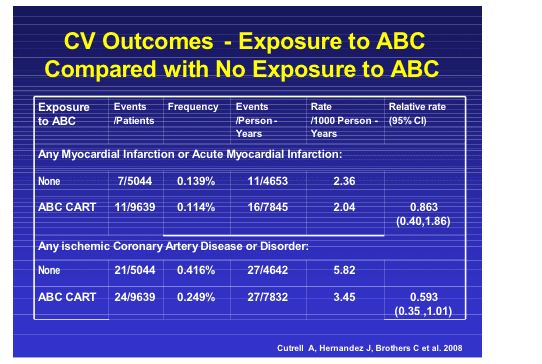
Overall, the GSK analysis indicated that among patients with data in the GSK HIV Data Repository, the overall incidence rate of myocardial infarction (MI) and coronary artery disease (CAD) was low. There was no difference in the incidence of ischemic CAD events or MI in persons receiving ABC-containing CART versus those receiving non-ABC-containing CART. These data are helpful, but the number of persons studied and the overall number of events was relatively low (a total of 18 MIs occurring among 14,683 patients followed), especially when compared to the numbers in the D:A:D study. Clearly this issue remains controversial and more information is required to clarify the risk-benefit ratio for the use of abacavir. Included in the information needed is an assessment of the relative risk of cardiovascular disease among those receiving tenofovir (as has been done for the other nucleoside analogues), an analysis not yet presented by the D:A:D study group.
The final presentation was a review of current understanding of cardiovascular disease among HIV-infected patients, bringing the session theme into focus by commenting on the role of HIV virus itself, the immune response to the infection, and evidence that antiretroviral drugs contribute. The issue is clearly quite complex and dissecting the interplay of the various factors requires an enormous amount of work using sophisticated and thoughtful analytic approaches. Much remains to be done as the promise of long term treatment success uncovers potential other issues that challenge the health of HIV-infected persons. It appears likely that contributions from HIV infection and the inflammatory response it engenders intersect with effects of antiretroviral agents, at least partly mediated through lipid changes. All these factors combine with a personÕs genetic background to impact the risk of cardiovascular disease. It is obviously an extremely complex cascade of events, and our understanding of the process is still growing. Cardiovascular disease in the setting of HIV infection represents an excellent example of the inflammatory debate and likely is a consequence of multiple events. Further exploration of this phenomenon will not only facilitate improved management of cardiovascular disease, but may also enhance our understanding of the important interplay between all three factors.
A Pilot Study of Urinary Markers of Endothelial Function & Oxidant Stress for the Prediction of Cardiovascular Disease Risk with Antiretroviral therapy
Michael S. Boger1, Ginger Milne2, Husamettin Erdem1,
Valerie Mitchell1, David W. Haas1, Jason Morrow2, Todd Hulgan1
Divisions of 1Infectious Diseases and 2Clinical Pharmacology
Department of Medicine
Vanderbilt University School of Medicine
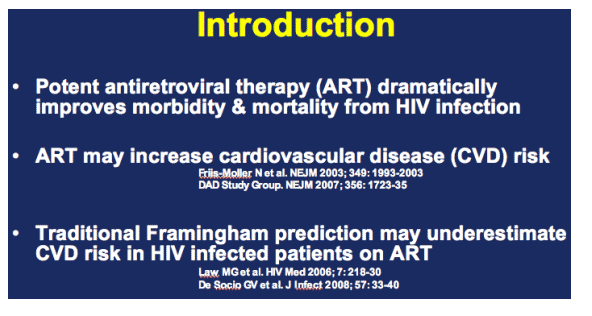
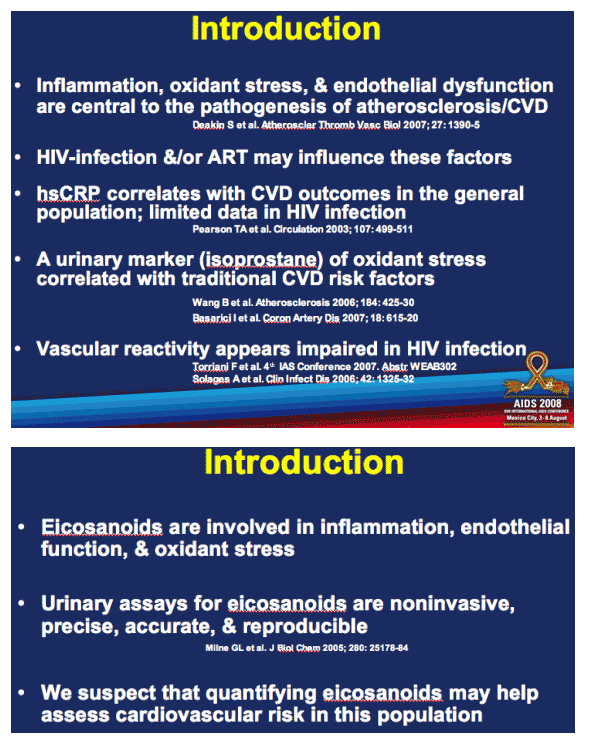
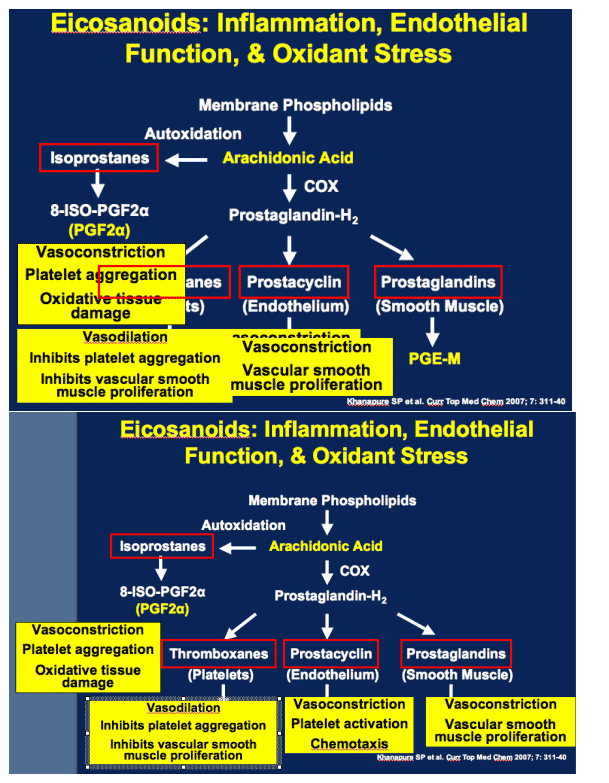
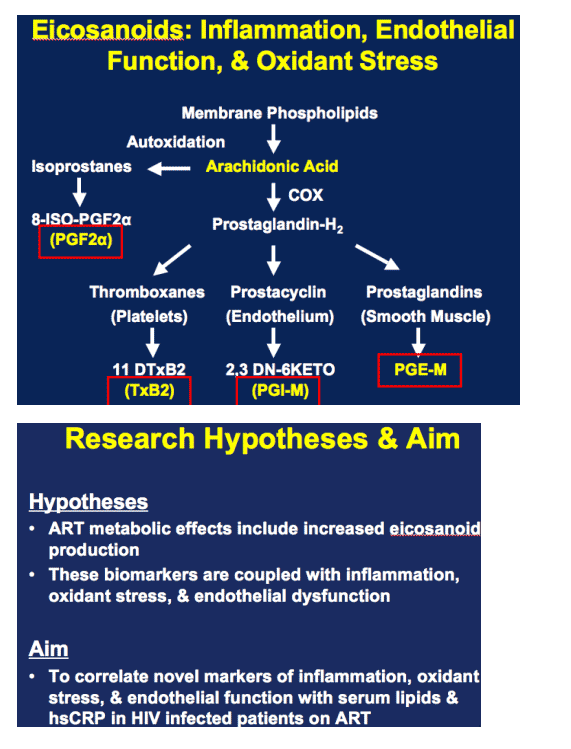
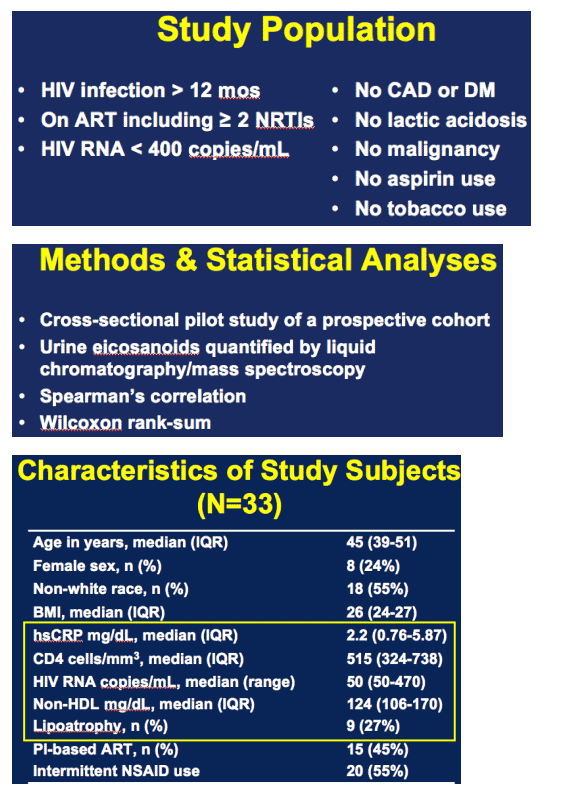
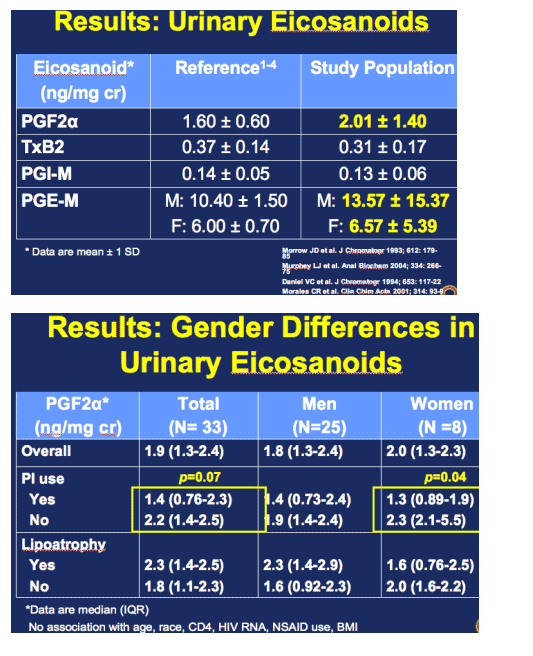
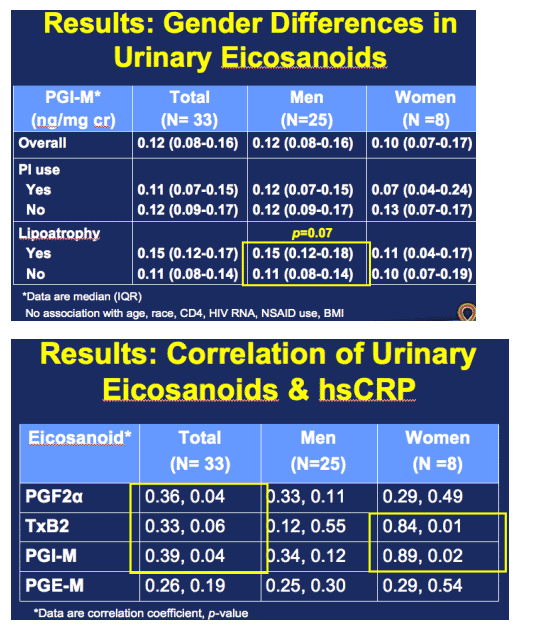
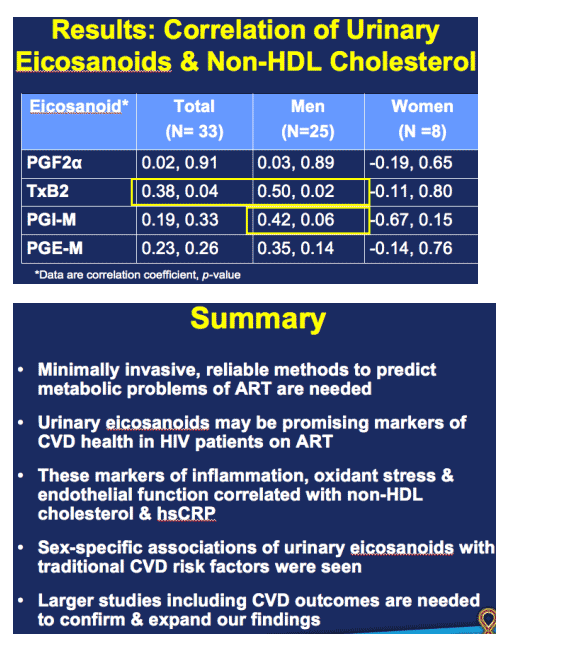
|
| |
|
 |
 |
|
|